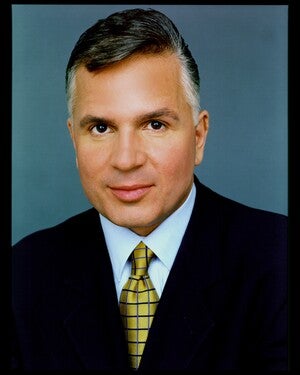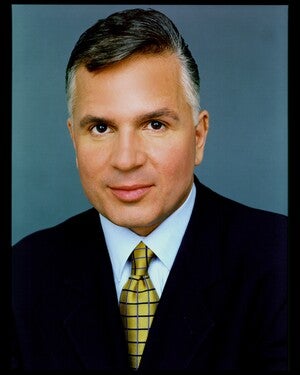Commercial real estate and the workplace are intertwined, or at least they were — until the COVID-19 pandemic disrupted both last year. With companies worldwide re-evaluating how the workplace of the future should look, commercial real estate is feeling a pinch.
Since COVID-19 was officially classified a global pandemic in March 2020, the US has shed 138.4 million square feet (MSF) of office space. That’s 34% more empty offices than the nation saw during the Great Recession of 2007-2010, according to Cushman & Wakefield, a global commercial real estate broker.
 JLL
JLLPeter Miscovich, managing director of JLL.
Peter Miscovich, the managing director of Jones Lang LaSalle IP (JLL), a global real estate investment and management firm, sees more disruption on the horizon as the pandemic rolls on and C-suite leaders embrace the hybrid workplace concept. (JLL manages more than 5 billion square feet of corporate real estate assets and its investment group oversees $73 billion in commercial real estate assets.)
Miscovich has the experience to speak with authority about how the workplace will evolve and what it means for real estate. He co-authored the book, “The Workplace You Need Now: Shaping Spaces for the Future of Work,” is a former Accenture and PWC advisory partner, and has been involved in workplace transformation since the early 1990s.
The following are excerpts from an interview with Miscovich, who ends with this prediction: “I don’t think we’ll ever return to the behaviors of December 2019 and before ever again.”
How are hybrid and more flexible workplace trends affecting commercial real estate? “In Lower Manhattan, since 2008 and The Great Recession, over 20 million square feet of commercial office space has been converted to residential space. I have several clients who’ve transformed their office space to senior living or assisted living facilities.
“I typically work with Fortune 50 clients…and their CEOs and leadership teams. They are really thinking about their human experience and human-centric workplace approach.
“In fact, there is premium to be paid for class A space in New York, and in Boston, and San Francisco, and London. They are all getting filled as we speak. Many of the class B and C spaces and more obsolete suburban campus locations or older, urban building stock may be looking at obsolescence or repurposing, as we saw post the Great Recession. [Class B and C buildings are typically older stock, or those located in a suburban setting, with fewer amenities and lower-tech infrastructure. Prior to the pandemic, many older buildings were considered desirable.]
“The future will be a hybrid, with these new ways to work at scale and it will involve technology enablement, including everything from virtual reality, hybrid workplace, and co-working. The workplace landscape will continue to evolve. The pandemic just served as an accelerate to that evolution.”
 JLL
JLLQuestions companies need to consider as they plan for workplace changes.
Q: How are real estate management firms sweetening the pot to entice companies to lease? “I’ve helped design more than 50 Fortune 100 headquarters. And in the good old days, you’d have a headquarters building that was 90% private offices and workspace and 10% collaborative space. We’re now looking at corporate headquarters that are 80 to 90% interactive and collaborative, and technology-enabled space and maybe 10 to 20% individual workspace. Individual work can be done at home, and people will go into the office to socialize, collaborate, and to build community.
“That trend was already under way in 2015, and we’ve done a lot of work and research into this topic at JLL. …That trend has also accelerated as a result of the pandemic — so, activity-based, human-centric design.
“I have client teams who come into the office from 8 a.m. to 1 p.m. to socialize and have meetings and then they go home from 1 p.m. to 7 p.m. to do email and their individual work. Those trend lines are continuing.”
Is that a bad thing for businesses? Will this new reality make it more difficult for them to entice workers? “I’ve worked for firms like Accenture for 30 years, and for firms like that it’s actually a great thing because allowing for flexible ways of working and allowing people to choose the way they want to work is good for the talent, it’s good for the employee and it’s good for the company. It’s also good for optimizing the real estate, and it’s good for the environment.”
Do you see office buildings going away altogether? “We will always need some. The question is: What does ‘some’ mean? I think [it means] a higher value office building experience that includes better amenities, better lighting, better air quality, better services, better technology, better views, and better transit. The question to ask is: Is your office commute worthy?”
How is a more agile workforce affecting the time we spend working? “The four-day work week is coming into play here. I think we’re going to see some very interesting new work behaviors as a result of this hybrid workforce, hybrid workplace transformation that’s occurring.”
How do you see the US, known as a nation of workaholics, actually transforming into a nation with a four-day work week? “Pre-pandemic, for many of my clients, people were commuting into the office only four days a week already. On Friday, they’d work from home. That started in 2005, actually. So, the question is, can you complete all of your work tasks Tuesday through Friday or Monday through Thursday, or any combination of days. I think the Europeans and some of the more progressed companies are already working toward this.
 JLL
JLLHow office space is carved up will evolve.
“For example, Microsoft in Japan has a popular study cited many times [in articles] showing that going to a four-day work week actually increased productivity in that Microsoft office by 40%. Unilever has also been piloting this.
“Who really knows if you put in a 40-hour week or a 45-hour week or a 32-hour week? I mean, the question should be more focused on outcome and creativity and innovation. Are we really measuring people by hours still? That’s perhaps a leftover relic of the Industrial Age that we’re finally going to be rid of, potentially.
“From a talent perspective, workers are looking for flexibility.”
You mentioned some buildings in lower Manhattan are being retrofitted for housing, in some cases senior living and elder care. What are some of the other ways buildings are being refitted for use other than office space? “A lot of the suburban locations now need more warehouse space, so commercial buildings are being refitted as warehouses. We’ve had office buildings converted to hotels. We’re seeing hotels getting converted to residential. We’ve seen suburban campuses get retrofitted to senior assisted and independent living. We’ve seen commercial buildings converted to very high-end residential, and that’s definitely been the case in lower Manhattan.
“So, do I need to come into the office two days a month, or two days a week? …I definitely don’t need to come in five days a week, and I don’t think we’ll ever return to the behaviors of December 2019 and before ever again.”



